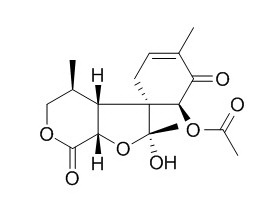O-Acetylcyclocalopin A
Standard reference
Inquire / Order:
manager@chemfaces.com
Technical Inquiries:
service@chemfaces.com
Tel:
+86-27-84237783
Fax:
+86-27-84254680
Address:
1 Building, No. 83, CheCheng Rd., Wuhan Economic and Technological Development Zone, Wuhan, Hubei 430056, PRC
Providing storage is as stated on the product vial and the vial is kept tightly sealed, the product can be stored for up to
24 months(2-8C).
Wherever possible, you should prepare and use solutions on the same day. However, if you need to make up stock solutions in advance, we recommend that you store the solution as aliquots in tightly sealed vials at -20C. Generally, these will be useable for up to two weeks. Before use, and prior to opening the vial we recommend that you allow your product to equilibrate to room temperature for at least 1 hour.
Need more advice on solubility, usage and handling? Please email to: service@chemfaces.com
The packaging of the product may have turned upside down during transportation, resulting in the natural compounds adhering to the neck or cap of the vial. take the vial out of its packaging and gently shake to let the compounds fall to the bottom of the vial. for liquid products, centrifuge at 200-500 RPM to gather the liquid at the bottom of the vial. try to avoid loss or contamination during handling.
In Vitro Cellular & Developmental Biology - Plant2022, 58:972-988.
J Agric Food Chem.2024, acs.jafc.4c01387.
Int J Mol Sci.2020, 21(19),7070.
Phytomedicine.2024, 122:155065.
Int. J. Mol. Sci.2022, 23(19), 11900.
International. J. of Food Properties 2017, 20:S131-S140
Natural Product Communications2021, 16(9):1-10.
Front Microbiol.2023, 14:1232039.
Pharmaceutical Chemistry Journal2019, 52(12):986-991
Revista Brasileira de Farmacognosia2021, 31:794-804.
Related and Featured Products
European Journal of Organic Chemistry, 2002 (17) :2895-2904
Calopins and cyclocalopins - Bitter principles from Boletus calupos and related mushrooms[Reference:
WebLink]
METHODS AND RESULTS:
Boletus calopus and closely related mushrooms of the Boletus section Calopodes are characterized by their bitter taste, which is caused mainly by O-Acetylcyclocalopin A (6a), a member of a series of unique δ-lactone derivatives. Besides the simple lactone calopin (1b) and its O-acetyl derivative la, the more complex cyclocalopins 6-12 have been isolated and their structures elucidated.
CONCLUSIONS:
Cyclocalopin D (10a) is an unprecedented α-glucoside in which the sugar residue is bound to an enolic hydroxy group., The chemical conversion of 6b into la established the same stereochemistry for the calopin and cyclocalopin types of metabolites.



